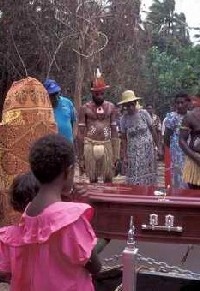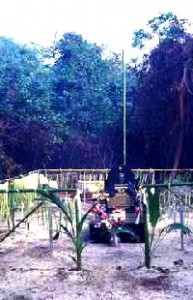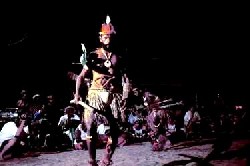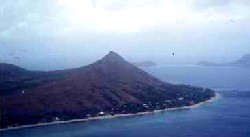First published in Good Weekend, June 1 1996.
The remains of the man whose name is synonymous with native title in Australia, Eddie Mabo, are finally laid to rest on Mer (or Murray Island).
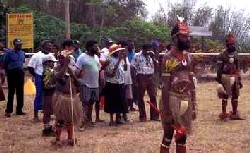
Bonita Mabo (in sun hat) and her extended family wait on the Murray Island runway as the plane carrying her late husband’s remains lands. Photo by Merrill Findlay.
It’s hot on the rim of this extinct volcano at the far northern end of the Great Barrier Reef. Bonita Mabo has been waiting in the shade of a battered fibro shed all morning. A small crowd has gathered around her: children, grandchildren, siblings, in-laws, cousins, aunts, uncles, members of the Meriam Council of Elders, young warriors from her late husband’s Piadram clan, a documentary film crew, plus this writer from Melbourne. And there it is, the light aircraft descending from the sky to bring the exhumed remains of Edward Koiki Mabo home to Mer, or Murray Island.
The plane lands, taxies towards us, turns and stops. Bonita rises from her improvised seat and joins her oldest natural son, Eddie Junior, on the grass runway. The pilot opens the freight door. The pall bearers drag the casket from the hold and carefully drape it with a blue and green Torres Strait flag. As the casket passes, the warriors lower their bows and clubs, and kneel. Bonita weeps. And slowly, chaotically, our small crowd becomes a straggling procession down the eastern side of this volcano to Koiki Mabo’s ancestral village of Las.
The land we are crossing has, as the seven judges of Australia’s High Court formally acknowledged four years ago (June 3 1992), belonged to the Meriam people since ‘time immemorial’, or at least since their Melanesian ancestors arrived from New Guinea an estimated 6,500 years ago.
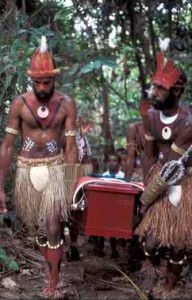
Young warriors from Eddie Mabo’s Piadram clan carry his casket through the bamboo forest on Mer. Photo by Merrill Findlay.
To contemporary Meriams, the traditional boundaries between the garden plots they inherited from their ancestors are as obvious as barbed wire fences and stone walls to people of European descent. And yet, for over a century after their island was annexed by the colony of Queensland in 1879, they were told that Mer and the two tiny islands off its coast, Dauar and Waier, belonged to ‘the Crown’.
While annexation changed many things on Mer, it did not destroy the traditional land tenure system, nor the continuity of Malo ra Gelar, or Malo’s Law, the oral code of traditional rights and obligations which remains central to Meriam culture.
According to elder Jack Wailu, Malo the law-giver was ‘a real man with a shark’s head’ who buried himself near Las ‘when his work on Mer was done’. The stories and moral code associated with this ancestral deity were quoted repeatedly by Eddie Mabo and his fellow plaintiffs in their High Court challenge to the concept of terra nullius, the legal fiction that Australia belonged to no-one before it was claimed by Europeans. Explains elder Mr Bua Mabo, (no direct relation of Eddie), ‘[Eddie’s] father and his mother, they always speak to him in the language and tell him stories about Las, about his father’s gardens, and about Malo’s laws. They tell him that Malo is his god, and that Murray Island is his island, that it’s been handed down from his ancestors.’ And this is what Eddie Mabo always believed.
Our straggling procession continues down the eastern side of the volcano. ‘You can feel the zogo here,’ another elder tells me. He means the sacredness, the spirituality of the place. The pall bearers rest the casket on a bier, or takar that has been built in a small clearing in the bamboo forest. Underneath it a symbolic fire has been set. We are walking in the steps of our ancestors, an elder says in the local blend of Meriam Mer, Torres Strait Creole and English. Before the missionaries arrived our ancestors dried the bodies of their leaders or Aets on a takar like this. They’d wait for the head to fall from the spine and then they’d remove the jaw and hang it on Malo’s sacred mask. We can’t do these things now, but it’s important that we remain as close as we can to our old ways, he says. That’s why we bring Uncle Eddie Koiki Mabo here today. Because, by his actions, he has shown us that he too was an Aet like his grandfathers before him. A great leader of his people.
The warriors lift the casket and we move on. Soon another dark and secret clearing, this one in a dense grove of coconut palms. Dead trunks lie across the ground and young ones are sprouting from last year’s fruit. Again an elder speaks. Malo was here, he says. You can feel him, you can see his Law.Malo wali aritarit, sem aritarit: Malo plants everywhere. Eburlem, esmaolem: Let it drop and rot on the ground.

The casket carrying Eddie Mabo’s remains enters the site of his ancestral village, Las. Photo by Merrill Findlay.
By now you can hear the roar of the surf on the coral reef — which means we’re close to Las. We enter the village along a narrow path lined with yet more coconut palms. The bamboo house Eddie and Bonita Mabo built has been demolished, and in its place a large white tent has been erected to accommodate family and friends. In front of the tent an ancient and very gnarled Wongai plum tree grows, and it is beneath this that the pall bearers now rest the casket.
The long journey from the Townsville cemetery, where Eddie was buried in January 1992, has been precipitated by an act of vandalism after the very public traditional tombstone unveiling last year on the third anniversary of the High Court’s Mabo decision. Eight red swastikas and the word ‘Abo’ were spray painted across the shining black granite and a bronze bas-relief portrait of Koiki was removed.
Explains Eddie Mabo Junior, ‘[Dad] was buried in Townsville because of Mum’s grieving, but after the desecration on the night of June 3, it was easy for her to say OK we’ll take him home. Especially since we couldn’t guarantee that it wouldn’t happen again, seeing he was such a high profile figure and an indigenous person as well.’
On the first night of Koiki Mabo’s return to Mer, Sager the south-east trade wind blows hard against the bamboo windbreak, and heavy rain falls. For no apparent reason the village dogs bark uncontrollably and children wake and whimper. At least one person sees Eddie on the beach. Another sees him walking along the track between the coconut palms. No-one seems surprised by this.
At dawn, Jack Wailu is waiting by the casket to perform a sacred ritual: the giving of a song to his late friend and neighbor’s eldest son. ‘My father learned me so I have to do it,’ Jack says. After breakfast, another ritual of more recent derivation: an ecumenical memorial church service. And another song.Mama namarida Mose mara memegle e naosa gair mara omaskir Israil le, the combined choirs of all the island churches sing in a capella harmony. You sent Moses your servant to lead the people of the Israelites from Egypt. Ekuaida mama gurgab gur damrikie mari adgirlam ko abele. By your blessing the waters parted because you are the way. (As Bua Mabo explains to me later when he translates the words of the hymn, ‘Koiki led the people of Murray Island from the bondage of terra nullius. This is what it means, that hymn.’)
At some invisible signal the pall bearers step forward, lift the casket and carry it back up the hill to a place overlooking the Coral sea. We gather around the freshly dug grave. A large tropical butterfly flutters by, the island doves coo, and in the background, the dull roar of waves crashing onto the reef. Chairperson of the Council of Elders, Sam Wailu speaks. ‘It’s a very historical case what Uncle won,’ he says. ‘And we welcome him home.’ He urges the young people to ‘follow Uncle’s example’.
The reading for this simple burial ceremony is Psalm 23: I will walk through the valley of the shadow of death and fear no evil. Sam Wailu gives the biblical metaphor contemporary meaning: indigenous people all over the world have to walk through the valley of the shadow of death as they struggle for their rights, he says in Creole. And again that liberation hymn: Mama namarida Mose …. You sent Moses your servant to lead the people …
As the families disperse, a young reporter from the Australian Broadcasting Corporation approaches Sam Wailu. This is the opportunity he has been waiting for. By evening his words are being heard throughout Australia: ‘Secession’, ‘Interim government’, ‘Oil’.
Expatriate landholder, Jim Ah Kee, has already faxed his own press statement from Cairns proclaiming that he will soon be returning to Mer to head an interim government, with, he says, the full support of the Council of Elders. His vision of the future is based on the exploitation of known Torres Strait oil and gas reserves which, he claims (probably spuriously), can be accessed from the small plot of tropical forest he now holds native title to on the island. As preposterous as Jim Ah Kee’s ideas might seem, they have at least forced landholders to consider a range of too-long ignored issues about their island’s future, including local governance, appropriate economic development and environmental management.
At present, however, the community remains deeply divided and confused about what native title actually means for them. As resident landholder and former chairperson of the Murray Island Community Council, Ron Day, admits, ‘We confused over understanding the implications of the [Mabo] decisions. We confused of our own responsibilities, our individual responsibilities in different areas of concern. We confused of what the [future] government [might] look like. We are not confused that Koiki is our champion. We are not confused on that. But Koiki has done his part.’
And now it is time to once more unveil his tombstone, the same one that was so seriously defaced in Townsville. Bonita leads us back up the hill to the grave site. Mama namarida Mose mara memegle e naosa gair mara omaskir Israil le, the islanders sing. ‘You sent Moses your servant to lead the people of the Israelites from Egypt …’
Slowly the long, bright lengths of cloth which have covered the now-repaired tombstone these past few days are unwound, and at last the words engraved into the black granite are revealed:
In loving memory of Edward Koiki Mabo, born Murray Island 29.6.36 died 21.1 1992 aged 56 years. Loving husband of Bonita, devoted father, father-in-law, grandfather, brother, brother-in-law, uncle and friend.
A Meriam man of Piadram clan.
Always loved. R.I.P.
As the Meriam flag unfurls and flutters above the shining tomb, the islanders sing their new national anthem: Mer thy name for us is lovely / Diadem in translucent sea …
The day passes and in the evening the final ceremonies. Jack Wailu is sitting in a plastic chair at the edge of a large pool of light. From somewhere deep within him, the words of an ancient chant. He’s beating the sacred drum of Malo as he sings, and from between the coconut palms, strange and marvelous figures in grass skirts emerge. Their bodies are painted with ochre. Soft white feathers are sprouting from their backs and abdomens, and from their forearms pink and green and yellow croton grows. Elaborate woven battle-guards protect their wrists, and around their waists and legs hang strings of shells. They move soundlessly from the darkness into the light with quirky bouncing sidesteps followed by deep pauses as the past seeps through them. They dance and then they disappear. Only to emerge again from the darkness …
Day Day, the last man to have danced this Malo cycle, passed away in Townsville two weeks before Eddie’s re-burial. But, before he died, he handed his knowledge on. One of the dances is about this very issue: the responsibility of each generation to ensure the continuity of the culture.
Again the dancers emerge from the darkness. One of them holds Seuriseuri, the sacred star-shaped club representing the wisdom of a people. One by one the warriors reach out to take Seuriseuri, and one by one they pass it on. As Jack Wailu explained to me later, ‘Eddie Mabo, he hold that club when he was dying, and somebody had to pick it up and go on and make our culture live.’
Soon that responsibility will pass to the next generation of Piadram warriors, the boys who are lying on their bellies at the edge of the dance ring. From out of the darkness, a huge and gloriously masked figure. The boys are transfixed. They will never forget this moment. And nor will we who are also watching. Because here is Malo, the giver of the laws. He is wearing a necklace of jawbones, one for each of the great Meriam leaders of the past. And behind him, his warriors moving to that ancient beat …
This story is dedicated to the late Leah Andrews, a Yorta Yorta community leader, who was my friend and a friend of the Mabo family. Leah rang me after the desecration of Koiki’s grave site in Townsville and asked me to accompany her to Mer for the re-burial and to write about it. When the time came she was too ill to travel herself and urged me to make the trip alone. My thanks to her always. And to the Mabo family with whom I camped on the beach at Las.
© This material is subject to copyright and any unauthorised use, copying or mirroring is prohibited.
Page revised and photos added 1 August, 2004. Content revised 5 January 2005 and 21 January 2008, and uploaded to this new site on 5 December 2010.

